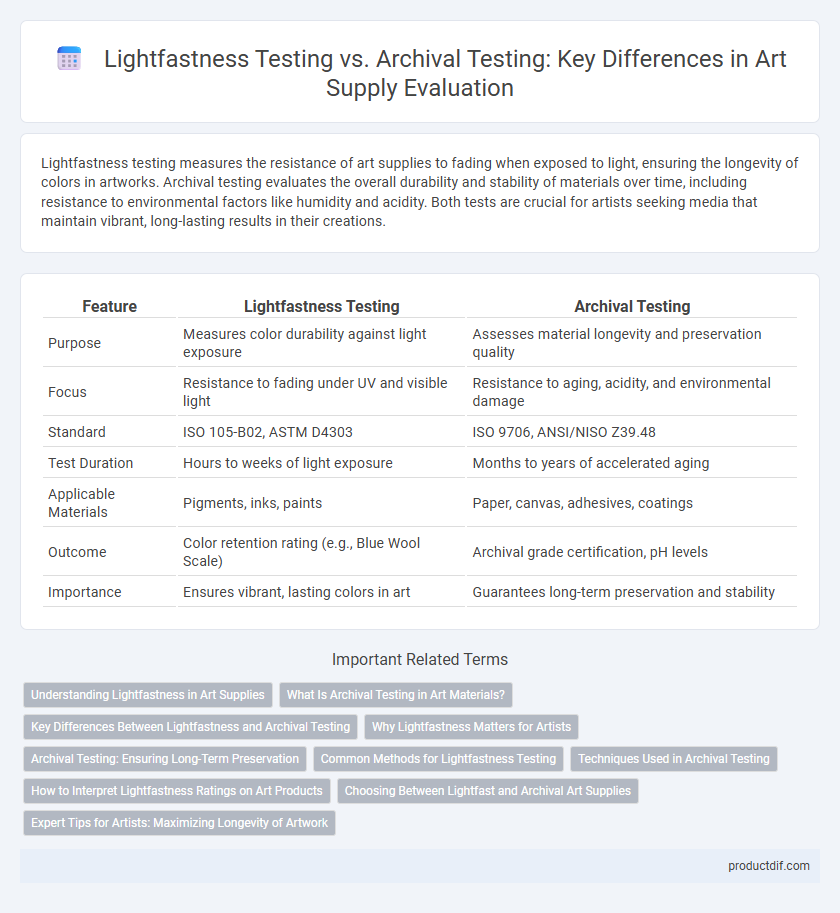Lightfastness testing measures the resistance of art supplies to fading when exposed to light, ensuring the longevity of colors in artworks. Archival testing evaluates the overall durability and stability of materials over time, including resistance to environmental factors like humidity and acidity. Both tests are crucial for artists seeking media that maintain vibrant, long-lasting results in their creations.
Table of Comparison
| Feature | Lightfastness Testing | Archival Testing |
|---|---|---|
| Purpose | Measures color durability against light exposure | Assesses material longevity and preservation quality |
| Focus | Resistance to fading under UV and visible light | Resistance to aging, acidity, and environmental damage |
| Standard | ISO 105-B02, ASTM D4303 | ISO 9706, ANSI/NISO Z39.48 |
| Test Duration | Hours to weeks of light exposure | Months to years of accelerated aging |
| Applicable Materials | Pigments, inks, paints | Paper, canvas, adhesives, coatings |
| Outcome | Color retention rating (e.g., Blue Wool Scale) | Archival grade certification, pH levels |
| Importance | Ensures vibrant, lasting colors in art | Guarantees long-term preservation and stability |
Understanding Lightfastness in Art Supplies
Lightfastness testing measures the resistance of pigments in art supplies to fading when exposed to light over time, ensuring color longevity in artworks. Archival testing evaluates the overall durability and stability of materials against environmental factors such as humidity and acidity, crucial for long-term preservation. Understanding lightfastness is essential for artists seeking colors that maintain vibrancy, as it directly impacts the artwork's lifespan and visual integrity.
What Is Archival Testing in Art Materials?
Archival testing in art materials assesses the long-term durability and stability of pigments, papers, and binders to ensure artworks retain their original appearance over decades or centuries. This testing evaluates resistance to environmental factors such as light, humidity, acidity, and pollutants, providing crucial data for museum-quality standards. Unlike lightfastness testing, which measures color fading specifically from light exposure, archival testing offers a comprehensive analysis of overall material preservation.
Key Differences Between Lightfastness and Archival Testing
Lightfastness testing measures the resistance of art materials like pigments and inks to fading when exposed to light, ensuring colors remain vibrant over time. Archival testing evaluates the overall durability and chemical stability of art supplies, including acid content and resistance to yellowing or deterioration, to guarantee long-term preservation. The key difference lies in lightfastness focusing on color stability under light exposure, while archival testing addresses broader factors affecting material longevity and protection in various environmental conditions.
Why Lightfastness Matters for Artists
Lightfastness testing measures the resistance of art materials to fading when exposed to light, ensuring the longevity of colors and vibrancy in artworks. Archival testing evaluates the overall durability and conservation suitability of materials over extended periods. Prioritizing lightfastness helps artists preserve the integrity of their work against exposure to natural and artificial light, maintaining artistic value and preventing color degradation.
Archival Testing: Ensuring Long-Term Preservation
Archival testing evaluates art supplies for their ability to maintain original qualities over extended periods, crucial for long-term preservation. This testing assesses resistance to environmental factors such as humidity, temperature fluctuations, and chemical degradation, ensuring artworks remain stable and protected. Prioritizing materials with rigorous archival testing results guarantees durability and authenticity for future generations.
Common Methods for Lightfastness Testing
Lightfastness testing commonly employs methods such as the ASTM D4303 and the Blue Wool Scale to evaluate an art supply's resistance to fading when exposed to light. These tests simulate prolonged light exposure using xenon arc lamps or fluorescent UV sources to determine pigment stability and color durability. Accurate lightfastness results are crucial for artists selecting materials that ensure long-lasting artwork under various lighting conditions.
Techniques Used in Archival Testing
Techniques used in archival testing emphasize long-term preservation through accelerated aging tests, colorimetric analysis, and microfade testing to evaluate material stability under various environmental conditions. These methods assess pigment integrity, substrate compatibility, and potential degradation pathways, ensuring art supplies meet stringent archival standards. Archival testing incorporates both chemical and physical evaluations to guarantee the longevity and durability of artistic materials.
How to Interpret Lightfastness Ratings on Art Products
Lightfastness ratings on art products indicate the durability of pigments when exposed to light, measured through standardized testing such as ASTM or Blue Wool scales. Interpreting these ratings involves understanding that higher ratings, often marked as I or II, signify superior resistance to fading and color degradation over time. Artists should prioritize materials with high lightfastness levels to ensure the longevity and archival quality of their work under various lighting conditions.
Choosing Between Lightfast and Archival Art Supplies
Lightfastness testing measures an artwork's resistance to fading when exposed to light, crucial for ensuring color longevity in visible displays. Archival testing evaluates materials for their overall durability and resistance to deterioration over time, including factors like acidity and chemical stability. Choosing between lightfast and archival art supplies depends on whether the primary goal is maintaining color integrity under light exposure or preserving the artwork's physical condition for long-term storage and handling.
Expert Tips for Artists: Maximizing Longevity of Artwork
Lightfastness testing measures how resistant art materials are to fading when exposed to light, ensuring pigments maintain their vibrancy over time. Archival testing evaluates the overall durability and chemical stability of materials, protecting artwork from deterioration due to environmental factors. Artists should prioritize materials with high lightfast ratings and archival certifications to maximize the longevity and preservation of their artwork.
Lightfastness Testing vs Archival Testing Infographic

 productdif.com
productdif.com